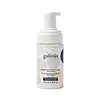What's inside
What's inside
 Key Ingredients
Key Ingredients

No key ingredients
 Benefits
Benefits

 Concerns
Concerns

 Ingredients Side-by-side
Ingredients Side-by-side

Water
Skin ConditioningCocamidopropyl Betaine
CleansingSodium Lauryl Glucose Carboxylate
CleansingLauryl Glucoside
CleansingGlycerin
HumectantLactic Acid
BufferingAlpha-Glucan Oligosaccharide
CleansingInulin
Skin ConditioningStyrene/Acrylates Copolymer
Sodium Chloride
MaskingCitric Acid
BufferingParfum
MaskingArginine
MaskingSorbic Acid
PreservativeSodium Hydroxide
BufferingTetrasodium Glutamate Diacetate
Sodium Benzoate
MaskingLimonene
PerfumingWater, Cocamidopropyl Betaine, Sodium Lauryl Glucose Carboxylate, Lauryl Glucoside, Glycerin, Lactic Acid, Alpha-Glucan Oligosaccharide, Inulin, Styrene/Acrylates Copolymer, Sodium Chloride, Citric Acid, Parfum, Arginine, Sorbic Acid, Sodium Hydroxide, Tetrasodium Glutamate Diacetate, Sodium Benzoate, Limonene
Water
Skin ConditioningSodium Lauryl Glucose Carboxylate
CleansingLauryl Glucoside
CleansingGlycereth-26
HumectantPropanediol
SolventDisodium Cocoyl Glutamate
CleansingPEG-7 Glyceryl Cocoate
EmulsifyingCeteareth-60 Myristyl Glycol
EmulsifyingDicaprylyl Ether
EmollientSorbic Acid
PreservativeLactic Acid
BufferingAcrylates Copolymer
Caprylhydroxamic Acid
1,2-Hexanediol
Skin ConditioningSodium Citrate
BufferingChlorphenesin
AntimicrobialWater, Sodium Lauryl Glucose Carboxylate, Lauryl Glucoside, Glycereth-26, Propanediol, Disodium Cocoyl Glutamate, PEG-7 Glyceryl Cocoate, Ceteareth-60 Myristyl Glycol, Dicaprylyl Ether, Sorbic Acid, Lactic Acid, Acrylates Copolymer, Caprylhydroxamic Acid, 1,2-Hexanediol, Sodium Citrate, Chlorphenesin
 Reviews
Reviews

Ingredients Explained
These ingredients are found in both products.
Ingredients higher up in an ingredient list are typically present in a larger amount.
Lactic Acid is another well-loved alpha hydroxy acid (AHA). It is gentler than glycolic acid but still highly effective.
Its main role is to exfoliate the surface of the skin by loosening the “glue” that holds dead skin cells together. Shedding those old cells leads to smoother, softer, and more even-toned skin.
Because lactic acid molecules are larger than glycolic acid, they don’t penetrate as deeply. This means they’re less likely to sting or irritate, making it a great choice for beginners or those with sensitive skin.
Like glycolic acid, it can:
Lactic acid also acts as a humectant (like hyaluronic acid). It can draw water into the skin to improve hydration and also plays a role in the skin's natural moisturizing factor (NMF) in the form of sodium lactate.
Studies show it can boost ceramide production to strengthen the skin barrier and even help balance the skin’s microbiome.
To get results, choose products with a pH between 3-4.
Lower strengths (5-12%) focus on surface exfoliation; higher strengths (12% and up) can reach deeper in the dermis (deeper, supportive layer) to improve skin texture and firmness over time.
Though it was originally derived from milk, most modern lactic acid used in skincare is vegan. It is made through non-dairy fermentation to create a bio-identical and stable form suitable for all formulations.
When lactic acid shows up near the end of an ingredient list, it usually means the brand added just a tiny amount to adjust the product’s pH.
Legend has it that Cleopatra used to bathe in sour milk to help reduce wrinkles.
Lactic acid is truly a gentle multitasker: it exfoliates, hydrates, strengthens, and brightens. It's a great ingredient for giving your skin a smooth, glowing, and healthy look without the harshness of stronger acids.
Read more about some other popular AHA's here:
Learn more about Lactic AcidLauryl Glucoside sugar- and lipid-based cleansing agent. It is created from glucose and lauryl alcohol.
This ingredient is a surfactant, making it easier to rinse oil, dirt, and other pollutants away.
A British study found lauryl glucoside to cause skin sensitivity for some people. We recommend speaking with a professional if you have concerns.
Other names for this ingredient include "Lauryl Polyglucose", "Lauryl glycoside", and "D-Glucopyranoside".
Learn more about Lauryl GlucosideWe don't have a description for Sodium Lauryl Glucose Carboxylate yet.
Sorbic Acid is a preservative. It is the most commonly used food preservative in the world.
Sorbic Acid is a natural antibiotic and highly effective at preventing the growth of fungus. It is less effective against bacteria.
Potassium Sorbate, another commonly-used preservative, is the potassium salt of Sorbic Acid.
Sorbic Acid may worsen eczema. We recommend speaking with a professional if you have any concerns.
Potassium sorbate and sorbic acid can be found in baked goods, cheeses, dried meats, dried fruit, ice cream, pickles, wine, yogurt, and more.
Learn more about Sorbic AcidWater. It's the most common cosmetic ingredient of all. You'll usually see it at the top of ingredient lists, meaning that it makes up the largest part of the product.
So why is it so popular? Water most often acts as a solvent - this means that it helps dissolve other ingredients into the formulation.
You'll also recognize water as that liquid we all need to stay alive. If you see this, drink a glass of water. Stay hydrated!
Learn more about Water